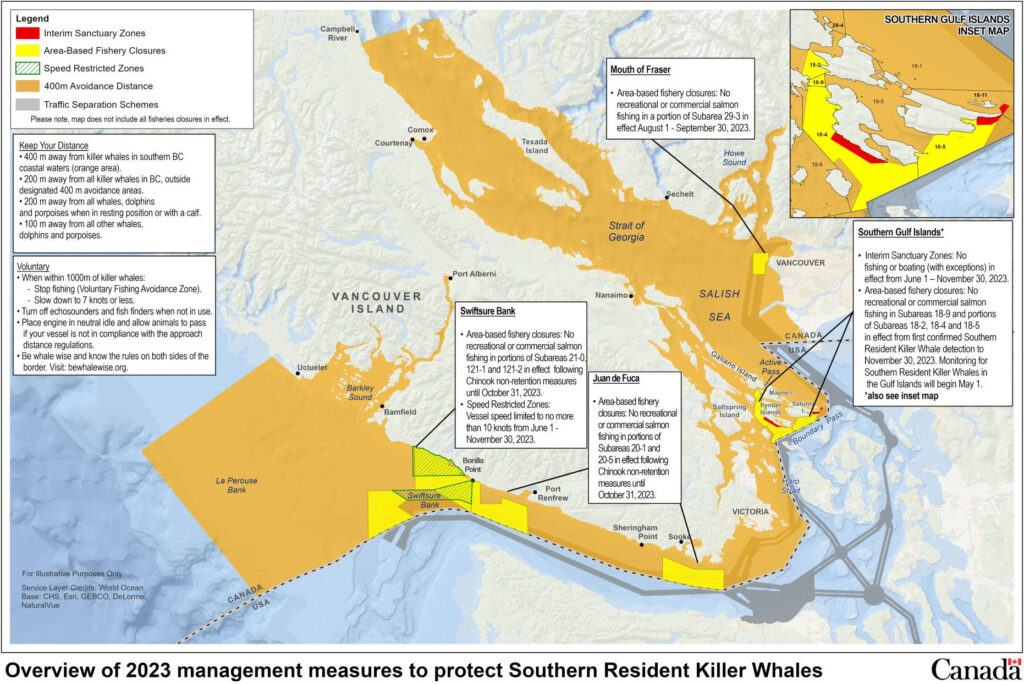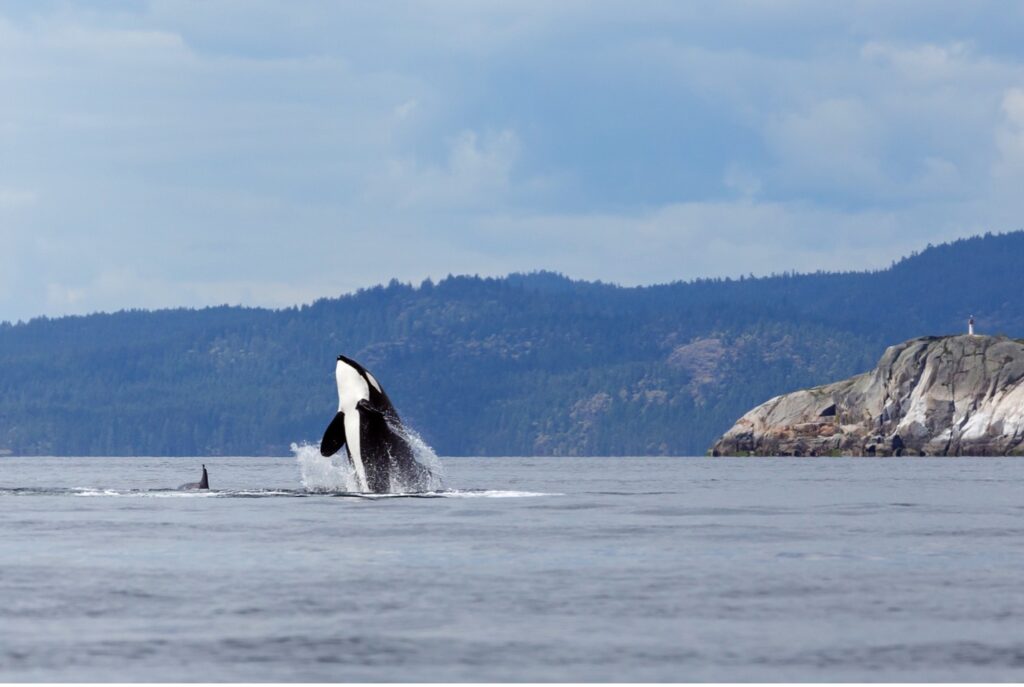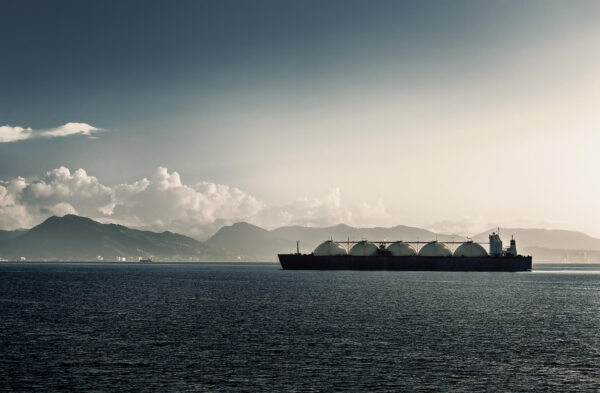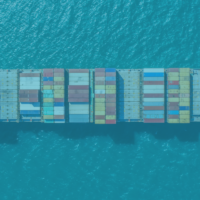With more than 27,000 km of coastline that extends from Alaska to Washington State, Canada’s Pacific region is home to a rich and vibrant marine ecosystem. Thousands of sea creatures inhabit these waters, from microscopic species to large, fascinating mammals. Among them are the highly intelligent and iconic orcas, also known as killer whales.
Contrary to what their name suggests, orcas belong to the dolphin family. It is said that they were attributed the name ‘killer whales’ by a group of sailors after they witnessed a pod of orcas preying on other large whales. Canada’s Pacific region is home to three populations of killer whales: the threatened and mammal eating Transients as well as the endangered and fish eating Northern and Southern Resident killer whales.
Although a small population remains, the number of killer whales residing in the southern waters of British Columbia – the Southern Residents – has been falling over the past decades. A decline in salmon stocks, which is their main source of food, is considered the primary threat to their survival. However, acoustic disturbances from commercial shipping activities and pleasure craft, ship strikes, and marine pollution continue to threaten the survival of Southern Resident killer whales.
With 70-80% of all the items used daily in Canada delivered by ships, an increasing demand for marine transportation and thousands of commercial ships transiting through the coastal waters of British Columbia every year, how are the effects of marine shipping on Southern Resident killer whales (SRKWs) and their habitats being relieved and what is the marine shipping industry doing to help protect this endangered orca population?
Orcas: Sacred creatures of the sea
Indigenous views:
“What you call Orca/Killer Whale, we as indigenous people at Tsleil Waututh Nation say in our language is Blackfish. In the time before contact Tsleil Waututh people lived in harmony with our surroundings and learned from everything in it. That knowledge we lived our daily lives by, but has never been written only handed down verbally through stories and songs through the generations.
There’s a common deep respect and a love that flowed from Tsleil Waututh people to our environment, the rooted ones, the feathered ones, the four legged and the finned ones. We learnt of the blackfish rituals and how they mapped out their habitat, their hunting ‘grounds’ and we in return respected that. The common piece for them & us was family; how we provided, protected, fed, taught and handed down ancient songs to our young ones. The Blackfish grandmother (Matriarch) carries the family songs then teaches them to the young whales. We have very similar beliefs. This type of communication has been muffled and choked out by the ever changing environment around the Salish Sea but the deep respect and understanding still remains and runs in our veins today.”
hay čxʷ q̓ə siʔem̓
Charlene Aleck

Southern Resident killer whales: How many are left?
With an estimated population of just 73 individuals remaining,1,2 SRKWs are one of the most endangered species of large cetaceans. They have been listed under Canada’s Species at Risk Act since 2003 and have not yet shown signs of recovery. To help slow down the population’s decline and address the threats to their survival, in 2011 Canada developed a recovery strategy comprised of numerous actions aimed at:
- Monitoring the Resident killer whale populations and their movements;
- Ensuring the availability of prey (Chinook Salmon) and accessibility to sufficient food;
- Reducing physical and acoustic disturbance of human activities on Resident killer whales;
- Preventing and mitigating the impacts of marine pollutants on Resident killer whales; and
- Protecting and preserving their critical habitats.
Where do Southern Resident killer whales live?
SRKWs reside along the Pacific Northwest coast of the United States and Canada’s west coast, from northern British Columbia to central California. From May until November, they tend to congregate in the Salish Sea, cruising the southern waters of Vancouver Island, the Strait of Juan de Fuca, the Haro Strait, and the Strait of Georgia.3 These areas of the Salish Sea, on both sides of the Canada-U.S. border, also constitute the Southern Residents’ critical habitat – which is considered essential to their survival and recovery.

What are the effects of commercial marine shipping on Southern Resident killer whales?
As the gateway for trade with Asia and the American west coast, Canada’s Pacific region is an important marine shipping hub and home to many ports including the Port of Vancouver, Canada’s largest port. Every day, dozens of vessels, from tugboats to large container ships, transit through the SRKWs’ critical habitat, which threatens them with acoustic and physical disturbance as well as marine pollution.
Acoustic disturbance
Marine shipping is one of the main sources of human-generated underwater noise. Marine mammals such as whales and dolphins depend on sound to survive as they use certain frequencies to communicate, feed, navigate, reproduce, and avoid danger. The propellers, engines, and onboard machinery of motorized vessels – from small pleasure boats to large merchant vessels – produce a range of frequencies from 20 all the way up to 100,000 Hertz and interfere with the frequencies orcas use to manoeuvre, avoid danger, find prey and, for their very survival.
Coastal waters such as those where the Southern Residents dwell are particularly susceptible to human-induced underwater noise because these sheltered waters are interlaced with a web of shipping lanes and active ferry routes. They are also the gateway to numerous ports and terminals, including the ports of Chemainus, Nanaimo and Vancouver, which make them an active area for higher levels of acoustic disturbance that can jeopardize the safety and existence of the Southern Resident orcas.
Physical disturbance
Because the movements of marine mammals are difficult if not impossible to predict, ship strikes pose another serious threat to SRKWs, as they do to North Atlantic right whales on the Atlantic Coast and in the Gulf of St. Lawrence. In the event of a collision, a ship’s hull and propellers can cause severe injuries and deadly trauma to orcas. Although Canada’s Marine Mammal Regulations require vessels to keep a minimum distance of 200 to 400 metres from killer whales in British Columbia’s coastal waters, they may inadvertently come across orcas. And, when these encounters occur, whales may not have the ability or agility to quickly avoid the moving ship. Similarly, due to their size and weight, it is not always feasible for commercial vessels to safely change course to avoid these mammals. Moreover, the acoustical disturbances may impair the navigational capabilities of orcas, further hampering their ability to take evasive action.
Marine pollution
Marine pollution such as an oil spill originating from a ship could have a disastrous impact on the SRKW population. Depending on the type, toxicity and behaviour in water, oil spilled by ships – whether fuel or cargo – would harm orcas and other marine mammals directly. Furthermore, spilled oil can contaminate the food sources – Chinook salmon, Chum salmon and others – they feed on, threatening their health and survival. Even if the risk of an oil spill is low due to safety measures such as double hulls, escort tugs, highly trained local marine pilots, inspections and aerial surveillance, a single major incident could endanger the orcas and their habitat.
What is Canada doing to help protect endangered Southern Resident killer whales?
To address the main threats to the SRKW population, the Government of Canada has implemented a series of protective measures under the Oceans Protection Plan, and the Whale Initiative. This includes voluntary vessel slowdowns in Haro Strait (the eastern channel separating Vancouver Island and the Gulf Islands) and lateral displacement trials in the Strait of Juan de Fuca (the channel running between the south of Vancouver Island and the north of Washington State’s Olympic Peninsula) – where vessels are asked to use shipping lanes furthest away from the whales’ habitat. The results of these trials have shown this to be an effective measure in reducing the level of ship-source underwater noise. Transport Canada is now studying the feasibility of permanently changing the paths and locations of the shipping lanes in these key foraging areas.
Quiet Vessel Initiative
Canada is investing in research aimed at improving the underwater noise footprint of ships by rethinking their design and by developing adaptive noise-reducing technologies. A variety of projects are funded through Transport Canada’s Quiet Vessel Initiative, including Clear Seas’ Smart Adaptive Solutions to Underwater Noise from Ships research, conducted in collaboration with researchers at the University of British Columbia.
Marine Mammal Desk
Canada’s first Marine Mammal Desk was recently established in the Canadian Coast Guard’s Marine Communication and Traffic Services Centre in Sidney on Vancouver Island. It helps to protect whales from the risk of ship strikes and entanglements by reporting, in real-time, the sightings and activities of SRKWs, and advises vessel traffic. Data collected by radar, satellites, Coast Guard vessels and aircraft from the National Aerial Surveillance Program is used to monitor whale movements, prevent collisions, and ensure compliance with the vessel traffic management measures in place to protect the Southern Resident killer whales. As shared by the Canadian Coast Guard, “2021 was the first full year the Marine Mammal Desk was in operation. Over the course of the year, the desk actioned 197 Interim Order Contravention Reports, 22 Mammal Incident Reports, and 234 Sightings and Observation Reports. This information was shared with agencies such as Transport Canada, Parks Canada, and Fisheries and Oceans Canada’s Conservation and Protection Unit and the Whale Protection Unit. In 2021, the Marine Mammal Desk also worked with the Royal Canadian Navy on two separate occasions supporting large-scale international exercises by providing historical and near-real time sightings data in the area of operation.”
National working group on underwater noise
In February 2021, Transport Canada established a National Working Group on Underwater Vessel Noise Source Reduction Targets, comprised of technical experts, and representatives from industry, environmental non-government organizations and academia. This group is expected to help reduce the level of underwater noise produced by ships by establishing meaningful noise targets and assessing various technological solutions to achieving them.
Seasonal management measures – 2023 update
Since 2019, the federal government has put in place additional seasonal measures to further protect the SRKWs. Besides the closures of commercial and recreational salmon fisheries and increased research and education efforts on marine contaminants, other seasonal measures include:
- Seasonal slowdown areas in which vessels must limit their speed to a maximum of 10 knots, from June 1 until November 30;
- A prohibition, for all vessels, to approach any killer whales within a 400-metre distance in the coastal waters of southern British Columbia; and
- The establishment of temporary sanctuary zones (from June 1 until November 30) closed to vessel traffic, with the exception of emergency response vessels and vessels involved in Indigenous fishing for food, social and ceremonial purposes.

New for 2023, Transport Canada announced that the Southern Gulf Islands closure protocol for commercial and recreational salmon fisheries will be in effect from the first confirmed presence of Southern Resident killer whales in the area and extend to November 30, 2023. This effort recognizes that Southern Resident killer whales are being reported in the Salish Sea in greater numbers later into the fall. Full details are available here.
Is the marine shipping industry taking action to minimize its impacts on Southern Resident killer whales?
A number of initiatives have been undertaken by the marine shipping industry, First Nations, governments and non-government organizations to help protect Southern Resident killer whales.
Guidelines for the Reduction of Underwater Noise from Ships – IMO
The International Maritime Organization (IMO), the agency responsible for the regulatory framework governing marine shipping, has issued draft revised guidelines in January 2023 for the reduction of underwater noise from commercial ships to address adverse impacts on marine life. These non-mandatory draft revised guidelines provide an overview of approaches applicable to designers, shipbuilders and ship operators to reduce the underwater radiated noise of any given ship, such as quieter propellers and onboard machinery, speed reductions, and hull cleaning to reduce ships’ resistance through water. The draft revised guidelines will be submitted to the Marine Environment Protection Committee (MEPC 80) in July 2023 for approval. The revisions include new technical knowledge, such as international measurement standards and classification society rules, and aim to assist shipowners in developing an underwater radiated noise management plan.
Enhancing Cetacean Habitat and Observation Program – Vancouver Fraser Port Authority
In collaboration with multiple partners from government, industry, academia, First Nations, and non-government organizations, the Vancouver Fraser Port Authority (VFPA) has initiated and led the Enhancing Cetacean Habitat and Observation (ECHO) Program. Established in 2014, the objective of this program is to develop and implement initiatives that lead to concrete, quantifiable reductions in the threats to whales originating from marine shipping. The ECHO Program and Transport Canada currently support a listening station in Boundary Pass and dozens of research trials and educational projects designed to help better understand the effects marine shipping activities can have on whales, with a special focus on ship-generated underwater noise. Initiatives such as seasonal voluntary vessel slowdown trials in Swiftsure Bank, Haro Strait and Boundary Pass, and requesting that commercial shipping vessels reduce their speed to a maximum of 11 to 14.5 knots depending on their type, have so far been successful.4 Over the years, participation rates of above 80% resulted in reductions ranging from 40% to up to 55% of ship-generated underwater noise intensity in these areas.5 A voluntary inshore lateral displacement in the Strait of Juan the Fuca initiated in 2018 has also led to a reduction of up to 70% of the underwater noise intensity on a per-transit basis for tugboats transiting the area.6
According to the VFPA’s annual report, as of 2022, the ECHO program achieved a number of firsts. The program has seen the implementation of underwater noise reduction initiatives over the largest geographical area to date –– covering nearly 80 nautical miles of the Salish Sea. It also achieved its highest participation rate, with 86% of all large commercial ships slowing down or keeping their distance from key areas of Southern Resident killer whale critical habitat.
Other initiatives implemented under the ECHO program include the monitoring of underwater noise levels in the busy Burrard Inlet, conducted in close collaboration with the Tsleil-Waututh Nation, and the Whales in our Waters online tutorial designed to help vessel operators and crews learn more about the whale populations present in the area and how they can be identified and avoided.
EcoAction Program – Vancouver Fraser Port Authority
To help reduce the threat of underwater noise from ships on SRKWs and other marine mammals, the VFPA encourages vessels transiting in the area to quiet the waters, through the EcoAction environmental stewardship program. As part of the program, reduced harbour dues are awarded to ships equipped with noise reduction technologies – such as energy saving devices for propellers – that are calling at the Port of Vancouver.
Green Wave Environmental Incentive Program – Port of Prince Rupert
The Port of Prince Rupert (PPP) also rewards quieter vessels visiting its terminals with reduced harbour dues to encourage ship owners and operators to implement technologies and adopt operational practices that contribute to reduce the underwater noise footprint of the commercial vessels transiting the region. The PPP ’s Green Wave environmental program outlines criteria for vessels to reduce underwater noise through environmental certifications, classification societies, and quieting technologies.
WhaleReport Alert System – Ocean Wise
To help mitigate the effects of marine shipping activities on whales in Canada’s Pacific Region, Ocean Wise, a global oceans conservation organization, developed and deployed the WhaleReport Alert System (WRAS) to alert commercial mariners to the presence of whales. Developed in collaboration with the marine shipping industry, coastal pilots, BC Ferries, and the Ports of Prince Rupert and Vancouver, WRAS is a mobile and desktop program that expands vessel monitoring systems and capabilities, and enables commercial ships to avoid whales in real time.
How are Southern Resident killer whales monitored and detected in Canadian waters?
Surveillance and monitoring are important activities to better understand the behaviours of SRKWs, their habits and migration patterns, and to implement effective measures and technologies that minimize the human induced threats to this endangered species. Air surveillance through the National Aerial Surveillance Program’s aircraft, the reporting of sightings via the Canadian Coast Guard’s Marine Mammal Desk and acoustic technologies, such as underwater microphones (hydrophones), are used to monitor and detect the presence of SRKWs in the Salish Sea.
Working with the Tsleil-Waututh Nation and other partners, the Port of Vancouver is also monitoring the presence of cetaceans, including Southern Resident killer whales in its busy harbour using noise monitoring terminals strategically located throughout the Burrard Inlet. Research organizations such as Ocean Networks Canada, the University of Victoria’s ocean observatory, is also paying close attention to the presence and movements of SRKWs in the Salish Sea with a network of underwater listening stations.
Are the initiatives in place enough to ensure the recovery of Southern Resident killer whales?
Government and the marine shipping industry have taken a wide range of steps to protect the SRKWs and reduce the threat that marine shipping and commercial fishing poses. And some results – such as seasonal vessel slowdowns and lateral displacement trials – have been quite promising. Still, the population remains threatened and even with the birth of some new calves hasn’t shown any real signs of recovery.
The key to the revival of the SRKWs rests on ensuring that they have access to a thriving supply of salmon that they can reliably feed upon. They must also be able to live in a clean, pollution free environment where human generated underwater noise doesn’t disrupt and interfere with their ability to communicate and hunt. A recent study conducted by scientists at the University of British Columbia’s Marine Mammal Research Unit and Oceans and Fisheries Canada found that the presence of vessels in the SRKWs habitat – and the underwater noise they generate – are factors that could impede their ability to successfully feed even when in presence of sufficient prey. In addition, SRKWs continue to be at very real risk to ship strikes.
While SRKWs remain endangered and their survival is in jeopardy, new technologies to make commercial vessels quieter and to provide real-time alerts to mariners of their presence hold out some promise for their survival. Hopefully, this partnership between industry, innovation and science will ensure that this iconic species will flourish once again.
References
1 Parks Canada. (2021). Protecting the Southern Resident Killer Whales.
2 Government of Canada. (2023) Input on recovery of Southern Resident killer whale potential management measures for 2023.
3 Government of Canada. (2021). Killer Whale (Orcinus orca), Northeast Pacific Southern Resident Population.
4 Vancouver Fraser Port Authority. (2022). Fact Sheet: Swiftsure Bank 2022 Voluntary Vessel Slowdown.
5 Vancouver Fraser Port Authority. (2023). Fact Sheet: Haro Strait and Boundary Pass 2023 Voluntary Vessel Slowdown.
6 Vancouver Fraser Port Authority. (2023). 2023 Strait of Juan de Fuca Voluntary Inshore Lateral Displacement.



